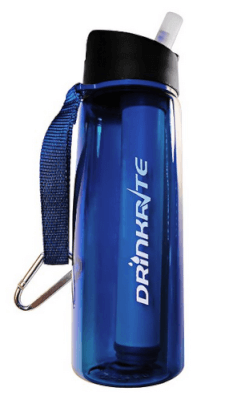
One of our favorites – find out why.
Is it safe?
“What’s that thumping noise in the back of the car? Oh, it’s that half-empty bottle of water, been in there since last week.”
I know you’re trying to be thrifty, but a half-empty plastic bottle of water is probably NOT something you want to drink from!
Not because it’s a plastic bottle, but because somebody’s lips were on it at some point and lips carry germs (probably bacteria of some sort, depending on what’s on your mouth or on your hands). Germs particularly love the threaded spout of that plastic bottle.
Give those germs a week or so to grow, in a nice warm environment, and . . . not so good!
Is there a difference in plastics?
The above paragraphs assumed a disposable plastic water bottle – the new thin kind, made of PET plastic. By being so thin, these bottles save energy (a lot less heavy to transport) and are recyclable. And they are not supposed to contain BPA, the chemical that created the concern some years ago and has been banned from baby bottles.
However, studies on water stored in PET bottles for a relatively long period of time (several weeks) at high temperatures show that chemicals from the plastic do leach into the water. Remember that the interior of your car, parked in the sun, can reach temperatures as high as 170 degrees!
In other words, pour that left-over water on a house plant, and then toss the bottle in the recycle bin.
A reusable sports bottle is a much better option.
Sports bottles designed for re-use are a much better option. They may be made of different materials — sometimes of steel or steel with a glass liner or of BPA-free plastic. They are often very stylish, have well-designed shapes, handles and spouts, and the large-mouth ones let you add ice cubes.
Depending on the material, you may pay anywhere from $10-20 for most reusable water bottles.
Refill directly from the tap. If you don’t like the taste or smell of your tap water, consider a filtered re-usable bottle. Filtered bottles cost very little more than un-filtered ones, but of course the filter may take up room inside the bottle.
For daily use you’ll get sweet-tasting water and probably drink more as a result!
Filtered bottles for survival have a better quality filtration system.
In an emergency, you may be filling your bottle with “questionable” water – from old supplies, from a pipe that may have been compromised, even directly from a lake or stream. In that case, you will be happy to have a high-quality filter between the water and your mouth.
New review on the site — five different survival water bottles, each under $50.
We selected these bottles for their price (As you can imagine, there are others costing far more.) and because each has a particular feature that will help you customize your purchase.
The features you probably want to consider:
- Size of bottle (how many ounces)
- Quality of filter (what does it filter out, what doesn’t it)
- How long will the filter last (how many gallons)
- Can you get a replacement filter
- Can you clean the filter and reuse
Last point. In every case, with every reusable water bottle, hygiene is essential.
Not all bottles are dish-washer safe (That may be something you look for.) but they can all be washed by hand with hot, soapy water, rinsed well (you can even add vinegar to the rinse water), and left to air dry. Experts suggest you clean your bottles – particularly those used by children or by people wearing lipstick or lip gloss – after every use, certainly at least once a week.
For even more info, please check out our new review: Best Personal Survival Water Bottles
Virginia
Your Emergency Plan Guide Team
Welcome to new readers! Don’t miss any of our posts. (We call ’em Advisories.) Sign up below to have Advisories delivered to you every week.
Don't miss a single Advisory.
Thank you for subscribing.
Something went wrong.
